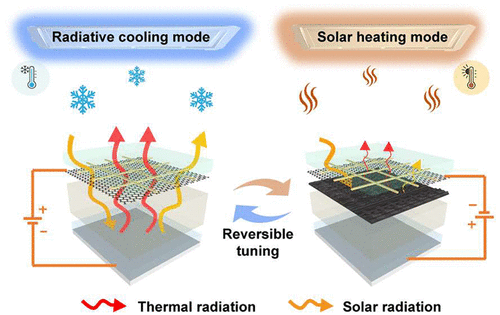You may have heard of electrochromic windows or sunglasses that can be electronically switched between clear and tinted states. Well, the same technology has been applied to a new material that could both heat and cool buildings, if mounted on their outside walls.
Although they don’t all work in exactly the same way, electrochromic devices typically incorporate two thin, clear layers of electrode material, with an electrically responsive material sandwiched between them. The latter material is transparent by default, but darkens when an electrical current flows between the electrode layers.
Developed by scientists at North Carolina’s Duke University, the new material works in a similar fashion. It incorporates two electrode layers made of graphene, each one of which has a gold grid deposited on one side to enhance its electrical conductivity. Between those layers is a liquid electrolyte that contains metal nanoparticles. On the bottom of the material is a layer of a reflective substance – a mirror, in other words.
When an electrical current flows between the electrodes, the nanoparticles respond by clustering together near the top electrode. This causes the electrolyte to turn black, so that it absorbs and traps both the visible and near-infrared spectra of incoming sunlight. The material heats up as a result, allowing it to augment the building’s existing heating system.
When the electrical current is reversed, the nanoparticles in the electrolyte spread apart, turning it transparent to reveal the underlying mirror. That mirror reflects the sunlight away from the material, plus it allows any near-infrared light (heat) that may be trapped behind it to escape. In this way, it helps the building to stay cool. It should be noted that the reflective layer is not transparent, so the material couldn’t be used as window glass.

Duke University
The scientists are now further developing the technology, which will include increasing the number of times it can cycle back and forth between clear and opaque states – it can currently only do so about 24 times before losing efficiency.
“I can envision this sort of technology forming a sort of envelope or facade for buildings to passively heat and cool them, greatly reducing the amount of energy our HVAC [heating, ventilation and air conditioning] systems have to consume,” says the lead scientist, Asst. Prof. Po-Chun Hsu. “I’m confident in this work and think its future direction is very promising.”
The research is described in a paper that was recently published in the journal American Chemical Society Energy Letters.
Source: Duke University via EurekAlert
Source of Article